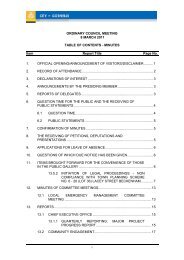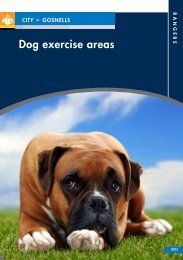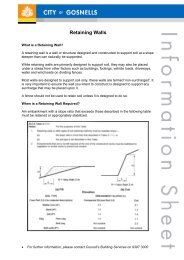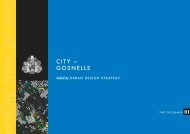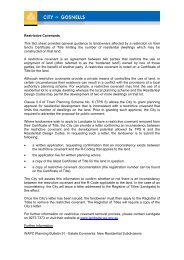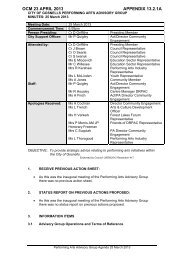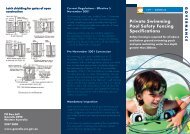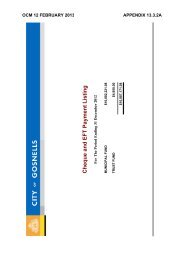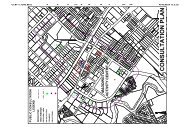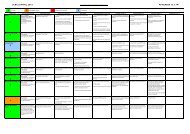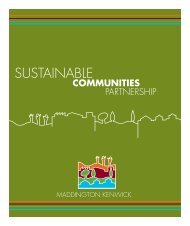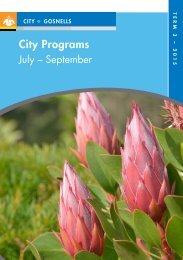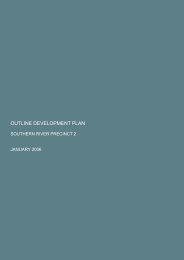Summary - City of Gosnells
Summary - City of Gosnells
Summary - City of Gosnells
You also want an ePaper? Increase the reach of your titles
YUMPU automatically turns print PDFs into web optimized ePapers that Google loves.
Flora 39It is anticipated that some <strong>of</strong> the taxa in the category <strong>of</strong> ‘taxonomic variants’ in Wattle Grove-Kenwick-Maddington, when fully described in the above manner, may prove to have a very restricted distributionand may be eligible for Priority Flora or DRF/Threatened Flora status.These taxa are indicated by the label ‘t’ in Appendix A.4.2 Flora Field SurveyThe native flora <strong>of</strong> the remnant vegetation <strong>of</strong> the MKSEA was found to be very species-rich. A total <strong>of</strong> 435taxa (330 taxa <strong>of</strong> native vascular flora and 105 taxa <strong>of</strong> naturalised alien flora) (Appendix B) were recorded inreconnaissance transects, in 32 sampling sites (quadrats and relevés), and opportunistically within theMKSEA footprint. Most sampling sites were visited at least three times between 2007and 2009 (includingwinter, spring and early summer); therefore, it is considered that a high proportion <strong>of</strong> the existing MKSEAflora was recorded.Three Threatened Flora Taxa (listed under the Federal EPBC Act as having national conservationsignificance), four Declared Rare Flora taxa and eight listed Priority Species (listed under the WesternAustralian State Wildlife Act and Western Australian Department <strong>of</strong> Environment and Conservation,respectively) were recorded in the MKSEA in the current survey.Approximately a third <strong>of</strong> the native flora recorded in the MKSEA in the current survey was considered tobe <strong>of</strong> regional conservation significance according the criteria <strong>of</strong> EPA (2004b) and Government <strong>of</strong>Western Australian (2000).In the current survey, the MKSEA was found to include a number <strong>of</strong> dune and wetland habitats that did notoccur in BFS 387 or BFS 53. However, the native vegetation <strong>of</strong> the MKSEA was fragmented amongst manysmall remnants, whereas most <strong>of</strong> the vegetation <strong>of</strong> the BFS 387 was mainly concentrated in a single polygon(although one dissected by a number <strong>of</strong> roads).The family composition <strong>of</strong> the native flora <strong>of</strong> the MKSEA was similar to that recorded in the Greater BrixtonStreet Wetlands (Table 4.1) although the MKSEA had a greater proportion <strong>of</strong> perennial taxa in the familiesMyrtaceae and Papilionaceae than BFS 387 did. Naturalised alien taxa (weeds) formed a larger percentage <strong>of</strong>the total flora in the MKSEA than in the total flora <strong>of</strong> the Greater Brixton Street Wetlands (Table 4.2). Thepercentage <strong>of</strong> native annuals in the total native flora <strong>of</strong> the MKSEA was low compared to the total for BFS387 but in excess <strong>of</strong> that found in some surveys <strong>of</strong> areas in BFS 387. The total number <strong>of</strong> native flora taxaand rare species and the percentage <strong>of</strong> native annuals recorded in the MKSEA in the current survey wasconsiderably in excess <strong>of</strong> that found in the same area by Cardno BSD (2005) (Tables 4.1 and 4.2).There was a mean <strong>of</strong> 42 taxa recorded per 10 m x 10 m quadrat in the MKSEA (range 9-67 taxa). The mostspecies-rich community types and habitats in the MKSEA (all <strong>of</strong> which are recognised by authorities ateither State or Federal level as Threatened Ecological Communities) were:1. Banksia woodlands on well-drained Bassendean Sands over the Guildford Formation (mean speciesrichness<strong>of</strong> 62 taxa per 100 m 2 ); and2. Shrublands on seasonally-waterlogged shallow muddy sand <strong>of</strong> the Guildford Formation (mean speciesrichness<strong>of</strong> 51 taxa per 100 m 2 ).The previously known flora <strong>of</strong> the Greater Brixton Street Wetlands (BFS 387), as compiled by Keighery andKeighery (2000) from numerous sources included at least 555 native taxa. More recent surveys (Keigheryand Tauss, 2008; Tauss, 2009) added an additional seven taxa to the tally for BFS 387. The current surveyfound 32 native taxa within the MKSEA (including at least three Priority Flora species) that have not beenrecorded previously in BFS 387 or BFS 53. One <strong>of</strong> the Declared Rare Flora Species found in the MKSEA inthe current survey (Eremophila glabra subsp. chlorella) is probably no longer extant in BFS 387.Tauss, C. and Weston, A.S. (2010). The flora, vegetation and wetlands <strong>of</strong> the Maddington-Kenwick Strategic Employment Area.A survey <strong>of</strong> the rural lands in the vicinity <strong>of</strong> the Greater Brixton Street Wetlands. Report to the <strong>City</strong> <strong>of</strong> <strong>Gosnells</strong>, W.A. Version 18.04.10



